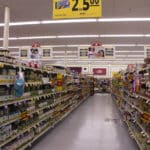
April 2nd was “Liberation Day,” when the White House announced new across-the-board tariffs on imported goods. April 3rd and 4th were then “stock the pantry while you still can” days.
Several recent studies and surveys show that shoppers are worried about potential price increases and continued market volatility, so they’re looking for ways to save. Some are clipping more coupons, some are buying less-expensive alternatives to their usual purchases – and some are buying everything they can now, before they can’t afford to anymore.
“We can begin to observe potential signs of stock-up activity,” a report from Consumer Edge noted. Their data showed that grocery shoppers bought more shelf-stable products than usual, in the two days immediately following this month’s tariff announcement. Purchases of canned and jarred vegetables were up 29% from the previous week, instant coffee purchases were up 21% and ketchup sales rose 18%. They also found an increase in average transaction size across major retailers like BJ’s, Costco and Target. “Is this the beginning of a broader consumer response to anticipated pricing pressure?” Consumer Edge asked.
It sure seems like it. Government figures released last week showed that retail sales were up 1.4% last month, the largest monthly gain in more than two years. “The rush is on like this is one gigantic clearance sale,” FWDBonds chief economist Christopher S. Rupkey wrote in a research note. “Consumers are expecting sharply higher prices the next year and are clearing the store shelves and picking up bargains while they can.”
For retailers who sell things like cars, appliances and electronics, that’s good news for the moment, as shoppers try to lock in lower prices on big-ticket items by buying now. But that’s not good news in the long run, because shoppers are spending now so they can avoid spending later.
Grocery retailers, however, seem to have less to worry about. “Widespread fears of weakening consumer spending in the grocery industry appear to be overblown,” SymphonyAI stated in its own report. “Shoppers claim to be tightening their belts,” yet data from the first quarter of the year shows that grocery spending is holding steady. Why? Because “consumers under economic stress who cut back on discretionary spending like dining out and traveling often find refuge in the comfort of grocery visits and enjoying meals at home, much as they did during COVID,” SymphonyAI surmised.
Data from Catalina also shows that grocery price inflation is easing. In studying ten common grocery product categories like frozen foods, cereal and coffee, Catalina found an overall inflation rate of 2% during the first quarter of this year, down from 3% the same time last year, and well below 2023’s full-year average of 16%. “However,” Catalina’s Adam Van Beck said, “we’re seeing early indicators that CPG marketers are preparing for tariff-related cost increases on imported raw materials such as coffee beans and aluminum for soft drink cans.”
And that has shoppers worried. Yet another report, this one from Numerator, found that 60% of the shoppers it surveyed were worried that groceries would be most impacted by tariff-related price increases. About half say they plan to look for more sales and coupons, while about a third expect to delay purchases until prices stabilize, stock up on items before prices go up, or buy fewer imported goods, and a quarter will switch to American-made alternatives.
“Changes in consumer sentiment are a leading indicator for changes in purchasing behaviors,” Numerator’s Chief Economist Dr. Leo Feler said in a statement. “And if consumers remain this pessimistic about the future of the U.S. economy, we can expect cutbacks in consumption going forward.”
One final report by Rakuten revealed much the same sentiment. 57% of the shoppers it surveyed said concerns about rising grocery prices have prompted them to cut back on non-essential shopping. 55% said they plan to prioritize products with the lowest prices when shopping in the coming months.
So how can sellers sell when buyers are reluctant to buy? By offering more coupons and deals, of course. “As shopper wallets tighten and marketer budgets increase, it’s time for retailers to get aggressive with their promotional strategies,” Rakuten Rewards’ Chief Revenue Officer Julie Van Ullen advised. Retailers “cannot assume that shopper loyalty will remain intact if they choose to pass the added costs onto the consumer by raising prices.”
Sellers and buyers alike are in a tough spot, then, as both watch for signals of where prices are headed, and how much excess cost they might be able to absorb. Those who are currently stocking their pantries might be buying themselves a few months of security. But they can only hope that whenever those supplies run out, their money hasn’t already run out, too.
Image source: Walmart










